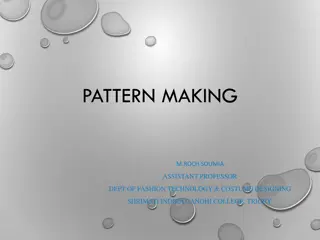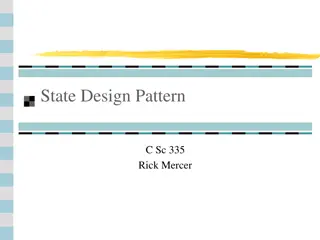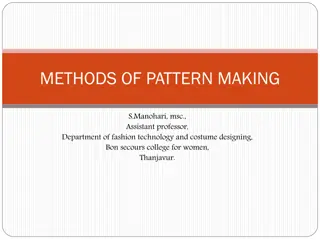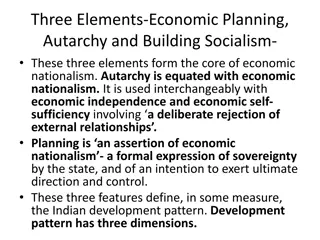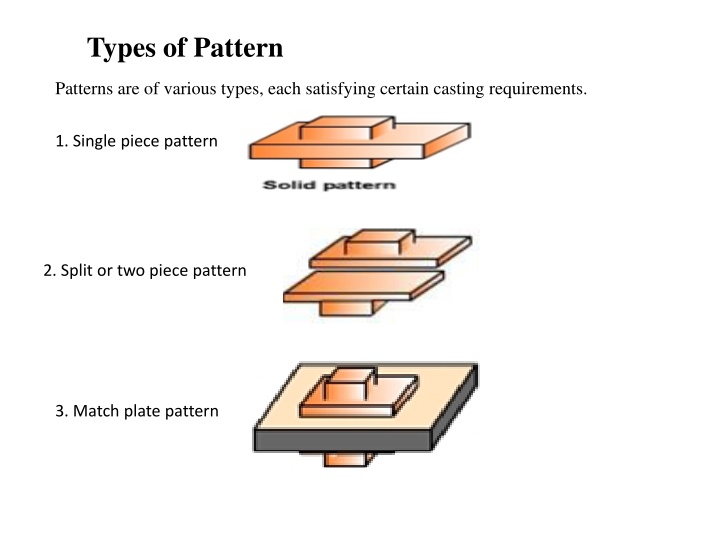
Types of Patterns and Molding Materials in Foundries
Discover the different types of patterns used in casting processes, including single piece, split, and match plate patterns. Learn about the properties of molding materials and the importance of refractoriness and permeability in foundry operations.
Download Presentation

Please find below an Image/Link to download the presentation.
The content on the website is provided AS IS for your information and personal use only. It may not be sold, licensed, or shared on other websites without obtaining consent from the author. If you encounter any issues during the download, it is possible that the publisher has removed the file from their server.
You are allowed to download the files provided on this website for personal or commercial use, subject to the condition that they are used lawfully. All files are the property of their respective owners.
The content on the website is provided AS IS for your information and personal use only. It may not be sold, licensed, or shared on other websites without obtaining consent from the author.
E N D
Presentation Transcript
Types of Pattern Patterns are of various types, each satisfying certain casting requirements. 1. Single piece pattern 2. Split or two piece pattern 3. Match plate pattern
Single Piece Pattern The one piece or single pattern is the most inexpensive of all types of patterns. This type of pattern is used only in cases where the job is very simple and does not create any withdrawal problems. It is also used for application in very small-scale production or in prototype development. This type of pattern is expected to be entirely in the drag and one of the surface is expected to be flat which is used as the parting plane. A gating system is made in the mold by cutting sand with the help of sand tools. If no such flat surface exists, the molding becomes complicated. A typical one-piece pattern is shown
Split or Two Piece Pattern Split or two piece pattern is most widely used type of pattern for intricate castings. It is split along the parting surface, the position of which is determined by the shape of the casting. One half of the pattern is molded in drag and the other half in cope. The two halves of the pattern must be aligned properly by making use of the dowel pins, which are fitted, to the cope half of the pattern. These dowel pins match with the precisely made holes in the drag half of the pattern. A typical split pattern of a cast iron wheel
Molding Material and Properties A large variety of molding materials is used in foundries for manufacturing molds and cores. They include molding sand system sand or backing sand facing sand parting sand core sand. The choice of molding materials is based on their processing properties
Refractoriness It is the ability of the molding material to resist the temperature of the liquid metal to be poured so that it does not get fused with the metal. The refractoriness of the silica sand is highest. Permeability During pouring and subsequent solidification of a casting, a large amount of gases and steam is generated. These gases are those that have been absorbed by the metal during melting, air absorbed from the atmosphere and the steam generated by the molding and core sand. If these gases are not allowed to escape from the mold, they would be entrapped inside the casting and cause casting defects. To overcome this problem the molding material must be porous. Proper venting of the mold also helps in escaping the gases that are generated inside the mold cavity ? =time ? =volume ? = specimen high(50.8 mm) ? = pressure ? = specimen cross section area diameter (50.8 mm) ? ? ? ? ? P= permeability number
Example : Calculate the permeability number if the sample of standard sand put in specimen tube (volume =2800 cm3) through 8.5 minutes of air at pressure 30g/cm2? ? ? ? ? ? = 2800 5.08 30 20.268 8.5 = 2.7521 P=
Green Strength The molding sand that contains moisture is termed as green sand. The green sand particles must have the ability to cling to each other to impart sufficient strength to the mold. The green sand must have enough strength so that the constructed mold retains its shape. Dry Strength When the molten metal is poured in the mold, the sand around the mold cavity is quickly converted into dry sand as the moisture in the sand evaporates due to the heat of the molten metal. At this stage the molding sand must posses the sufficient strength to retain the exact shape of the mold cavity and at the same time it must be able to withstand the metallostatic pressure of the liquid material.
HotStrength As soon as the moisture is eliminated, the sand would reach at a high temperature when the metal in the mold is still in liquid state. The strength of the sand that is required to hold the shape of the cavity is called hot strength. Collapsibility The molding sand should also have collapsibility so that during the contraction of the solidified casting it does not provide any resistance, which may result in cracks in the castings. Besides these specific properties the molding material should be cheap, reusable and should have good thermal conductivity
Molding Sand Composition The main ingredients of any molding sand are: Base sand, Binder, Moisture Base Sand Silica sand is most commonly used base sand. Other base sands that are also used for making mold are zircon sand, Chromate sand, and olivine sand. Silica sand is cheapest among all types of base sand and it is easily available.
Binder Binders are of many types such as: 1. Clay binders, 2. Organic binders and 3. Inorganic binders Clay binders are most commonly used binding agents mixed with the molding sands to provide the strength. The most popular clay types are: 1-Kaolinite or fire clay (Al2O3 2 SiO2 2 H2O) and 2- Bentonite (Al2O3 4 SiO2 nH2O) Of the two the Bentonite can absorb more water which increases its bonding power.
Moisture Clay acquires its bonding action only in the presence of the required amount of moisture. When water is added to clay, it penetrates the mixture and forms a microfilm, which coats the surface of each flake of the clay. The amount of water used should be properly controlled. This is because a part of the water, which coats the surface of the clay flakes, helps in bonding, while the remainder helps in improving the plasticity. A typical composition of molding sand is given in (Table) Molding Sand Constituent Weight Percent Silica sand 92 Clay (Sodium Bentonite) 8 Water 4







